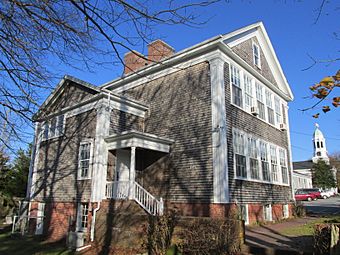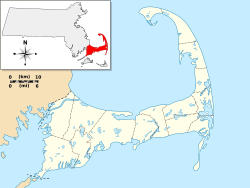Old King's Highway Historic District facts for kids
Quick facts for kids |
|
|
Old King's Highway Historic District
|
|

1854 Barnstable Village Schoolhouse
|
|
| Location | Barnstable, Massachusetts |
|---|---|
| Area | 1,150 acres (470 ha) |
| Architect | Lowell, Guy; Et al. |
| Architectural style | Greek Revival, Colonial, Georgian |
| MPS | Barnstable MRA |
| NRHP reference No. | 87000314 |
| Added to NRHP | March 12, 1987 |
The Old King's Highway Historic District is a special area in Barnstable, Massachusetts. It follows an old road that was once the main way to travel east and west through the town. This historic district covers the whole length of what is now called Massachusetts Route 6A or Main Street. It stretches between the towns of Sandwich and Yarmouth.
The district is huge, covering over 1,000 acres (400 ha). It includes almost 500 buildings that face this historic road. For a long time, from the late 1630s until the mid-1800s, this area was the main center of Barnstable. Later, other parts of the town became more important. The district was added to the National Register of Historic Places in 1987 because of its important history.
Contents
Exploring Old King's Highway
The Old King's Highway Historic District lets you step back in time. It shows how people lived and built things in Barnstable for hundreds of years. Many buildings here are very old and tell stories about the past.
Historic Buildings You Can See
Some of the oldest buildings in the district are still standing today. The Allyn House, located at 2730 Main Street, was built in the late 1600s. Another very old building is the Old Jail, built around 1690.
The Old Jail is super important because it's the oldest wooden jail in the entire United States! Today, it's part of a museum. This museum also includes the Old Customshouse. Both the Old Jail and the Customshouse are so historic that they are also listed separately on the National Register of Historic Places.
A Protest for Freedom
The old county courthouse, built in 1763, is at 3046 Route 6A. This building was the site of a big protest on September 27, 1774. People were upset with the British government. The British had passed a law called the Massachusetts Government Act in May 1774. This law took away many rights that the colony had enjoyed for a long time.
The protesters demanded that local officials refuse to follow this new British law. The officials agreed, and this effectively ended British control over the county. It was an important step towards the American Revolution. Later, in 1842, the courthouse building was changed into a church.
Why the Area Changed
In the early 1800s, Barnstable's economy started to change. People began to focus more on shipping and sea trade. This meant that villages along the southern coast of Barnstable became more important. Because of this shift, the villages along the King's Highway slowly became less important for business.
This change meant that fewer new buildings were constructed in the district. As a result, you can see many buildings from the Federal and Greek Revival styles. These styles were popular in the late 1700s and early 1800s. Even though the economy shifted, Barnstable Village, which stretches along the highway, remained the main center for county government. The Barnstable County Courthouse, built in 1831, is a key landmark showing this continued importance.




